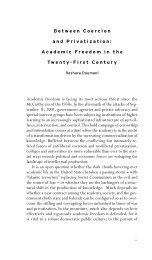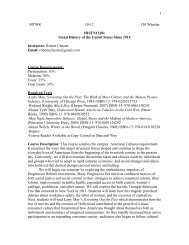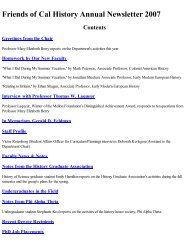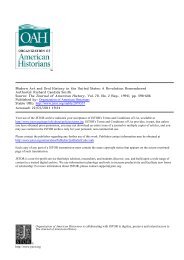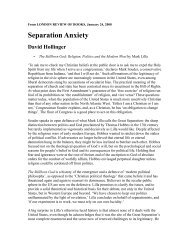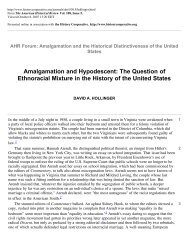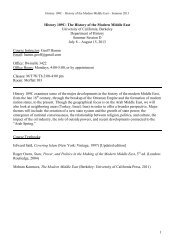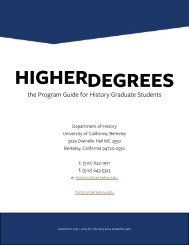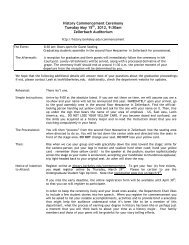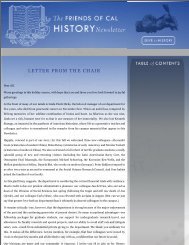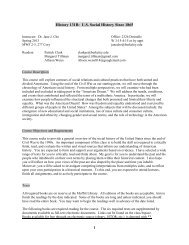My Grandmother and Other Stories: Histories of the Palestinians as ...
My Grandmother and Other Stories: Histories of the Palestinians as ...
My Grandmother and Other Stories: Histories of the Palestinians as ...
You also want an ePaper? Increase the reach of your titles
YUMPU automatically turns print PDFs into web optimized ePapers that Google loves.
to pursue <strong>the</strong> perpetrator after he w<strong>as</strong> rele<strong>as</strong>ed in 1930. Hussein paid no heed to <strong>the</strong><br />
threats that were made <strong>and</strong> did not accept <strong>the</strong> traditional dem<strong>and</strong> that he leave <strong>the</strong><br />
village, even if for a limited period <strong>of</strong> time. This stubbornness w<strong>as</strong> seen <strong>as</strong> a challenge<br />
<strong>and</strong> a provocation, <strong>and</strong> <strong>the</strong> relationship between <strong>the</strong> two extended families grew<br />
tense. Fights <strong>and</strong> conflicts between <strong>the</strong>m broke out, peaking in <strong>the</strong> killing <strong>of</strong> Khalil,<br />
Hussein’s fa<strong>the</strong>r, who attacked Zahra’s house, on 23 July, 1931 on <strong>the</strong> l<strong>and</strong> <strong>of</strong> Qalous. 17<br />
This incident <strong>and</strong> o<strong>the</strong>rs like it fed more disputes that extended over generations<br />
between <strong>the</strong> wider family <strong>of</strong> <strong>the</strong> attacker <strong>and</strong> <strong>the</strong> Manna’ family. <strong>O<strong>the</strong>r</strong> families in <strong>the</strong><br />
village took sides, while still o<strong>the</strong>rs tried to intervene to stop <strong>the</strong> fighting. This split<br />
extending even into <strong>the</strong> British M<strong>and</strong>ate period. Such family feuds were a key factor<br />
in weakening <strong>the</strong> cohesiveness <strong>of</strong> Palestinian communities despite external dangers,<br />
especially during <strong>the</strong> 1936-1939 rebellion. Indeed, <strong>the</strong> depth <strong>and</strong> dimensions <strong>of</strong> this<br />
social phenomenon far surp<strong>as</strong>s that time <strong>and</strong> place <strong>and</strong> have influenced Palestinian<br />
society before <strong>and</strong> after 1948. 18<br />
How w<strong>as</strong> Zahra al-Ja’uniyya affected by <strong>the</strong> events that were taking place around her?<br />
<strong>My</strong> gr<strong>and</strong>mo<strong>the</strong>r’s family returned from Ja’uni after Husssein Khalil w<strong>as</strong> imprisoned<br />
to again <strong>as</strong>k for permission to bring <strong>the</strong>ir daughter home. And again, Zahra preferred to<br />
live in Majd al-Kroum over returning to her hometown. However, this time she agreed to<br />
accept <strong>the</strong> proposal <strong>of</strong> Mohammed Hajj “Abu Ma’youf” to protect her <strong>and</strong> her children<br />
from attackers <strong>and</strong> wagging tongues. Thus, 1930 began a new period in <strong>the</strong> lives <strong>of</strong> my<br />
gr<strong>and</strong>mo<strong>the</strong>r <strong>and</strong> her children, <strong>the</strong> youngest <strong>of</strong> which w<strong>as</strong> my fa<strong>the</strong>r. Zahra al-Ja’uniyya<br />
lived with her third <strong>and</strong> l<strong>as</strong>t husb<strong>and</strong> for 18 years until his execution during <strong>the</strong> Nakba.<br />
<strong>My</strong> gr<strong>and</strong>mo<strong>the</strong>r bore her new husb<strong>and</strong> four children–Sa’da, Amneh, Sameeh <strong>and</strong><br />
Ahmad. She w<strong>as</strong> now mo<strong>the</strong>r to seven children from her two husb<strong>and</strong>s.<br />
Although Zahra al-Ja’uniyya’s life w<strong>as</strong> becoming more stable, Majd al-Kroum, like<br />
o<strong>the</strong>r villages <strong>and</strong> cities in Palestine, had been living through difficult times since <strong>the</strong><br />
close <strong>of</strong> <strong>the</strong> 1920s. Relations between Arabs <strong>and</strong> Jews in Palestine were tense from<br />
<strong>the</strong> end <strong>of</strong> 1928, reaching <strong>the</strong>ir nadir in <strong>the</strong> summer <strong>of</strong> 1929, when dozens <strong>of</strong> Jews<br />
were killed in Hebron. These bloody events also shook up <strong>the</strong> relatively neighbourly<br />
relations between Arabs <strong>and</strong> Jews in Safad, Tiberi<strong>as</strong> <strong>and</strong> o<strong>the</strong>r towns. So, while Zahra<br />
w<strong>as</strong> facing difficulties in her personal life, she also feared <strong>the</strong> political implications for<br />
her family in Ja’uni, who had lived side-by-side with <strong>the</strong> Jews <strong>of</strong> Rosh Pina ever since<br />
that Jewish settlement w<strong>as</strong> established in 1882.<br />
<strong>O<strong>the</strong>r</strong> commonplace events, ones rarely discussed in <strong>the</strong> political history <strong>of</strong> <strong>the</strong><br />
country, also made those days difficult. On 23 February, 1928, for instance, Abu<br />
Jamil recorded that “<strong>the</strong>re w<strong>as</strong> an earthquake on Thursday” which occurred <strong>as</strong> he w<strong>as</strong><br />
in “Shaykh Nabhan’s house in <strong>the</strong> company <strong>of</strong> Hussein al-Siba’i <strong>and</strong> Mohammad<br />
al-N<strong>as</strong>rawi”. 19 It seems that <strong>the</strong> earthquake itself did not do m<strong>as</strong>sive damage that<br />
Jerusalem Quarterly 30 [ 65 ]



